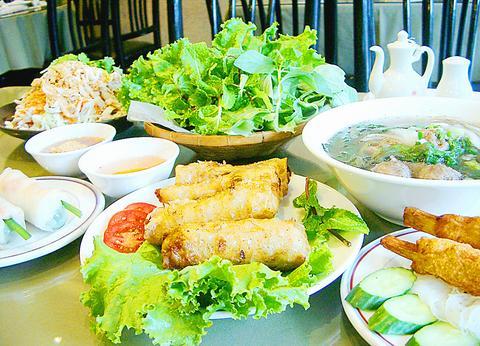Madame Jill's was the first Vietnamese restaurant to come to Taipei, when the Vietnam War was still raging. In 1974, the Lin family (overseas Chinese) moved to Taipei because of the war and set up the first branch of Madame Jill's, across the street from National Taiwan University. Over the past 30 years three other branches have been established and they remain frequently visited spots around the neighborhood.
With southeast Asian food becoming more popular in recent years and with more Vietnamese wives opening their own restaurants in the country, Madame Jill's nevertheless thrives, surviving the economic slump two years ago and the SARS outbreak last year.

PHOTO: YU SEN-LUN, TAIPEI TIMES
Asked if there were any secrets to maintaining the business, Liang Hai-ying (
"You want to make sure that each bowl of pho (rice noodles) tastes the same all the time," she said.
Chicken salad Vietnamese style is a refreshing starter, which is a mixture of shreds of cabbage, cucumber, chicken and carrots and sprinkled with peanut powder. It is then seasoned with fish sauce, a necessity in any Vietnamese dish.
"The fish sauce is the equivalent of soy sauce in Chinese cuisine. You season almost every dish with it," Liang said.
Spring Rolls are another must-try at Madame Jill's. There are two kinds of spring roll skins: Vietnamese style (made of rice) and Taiwanese style (made of flour). For sure, the Vietnamese style tastes better here, despite some local customers' preference for the other. The traditional method of preparation is to wrap the spring roll with a lettuce leaf, adding basil and mint leaves, which is then dipped in a home-made fish sauce. It tastes sweet and sour, and slightly spicy.
Though a bowl of rice noodles with beef in a soup is a often ordered as a main course, it is recommended that you order extra beef meatballs. For a more "colonial taste," one should try spicy coconut beef with French baguette. The bread is home made, Liang said.
Deserts here are a mixture of Thai, Malaysian and Vietnamese. The home-made laya cake is worth-trying, though. It is a green-colored, coconut flavored cake, made with the juice of laya tree leaves, a tropical tree common in Vietnam.

April 14 to April 20 In March 1947, Sising Katadrepan urged the government to drop the “high mountain people” (高山族) designation for Indigenous Taiwanese and refer to them as “Taiwan people” (台灣族). He considered the term derogatory, arguing that it made them sound like animals. The Taiwan Provincial Government agreed to stop using the term, stating that Indigenous Taiwanese suffered all sorts of discrimination and oppression under the Japanese and were forced to live in the mountains as outsiders to society. Now, under the new regime, they would be seen as equals, thus they should be henceforth

Last week, the the National Immigration Agency (NIA) told the legislature that more than 10,000 naturalized Taiwanese citizens from the People’s Republic of China (PRC) risked having their citizenship revoked if they failed to provide proof that they had renounced their Chinese household registration within the next three months. Renunciation is required under the Act Governing Relations Between the People of the Taiwan Area and the Mainland Area (臺灣地區與大陸地區人民關係條例), as amended in 2004, though it was only a legal requirement after 2000. Prior to that, it had been only an administrative requirement since the Nationality Act (國籍法) was established in

With over 80 works on display, this is Louise Bourgeois’ first solo show in Taiwan. Visitors are invited to traverse her world of love and hate, vengeance and acceptance, trauma and reconciliation. Dominating the entrance, the nine-foot-tall Crouching Spider (2003) greets visitors. The creature looms behind the glass facade, symbolic protector and gatekeeper to the intimate journey ahead. Bourgeois, best known for her giant spider sculptures, is one of the most influential artist of the twentieth century. Blending vulnerability and defiance through themes of sexuality, trauma and identity, her work reshaped the landscape of contemporary art with fearless honesty. “People are influenced by

The remains of this Japanese-era trail designed to protect the camphor industry make for a scenic day-hike, a fascinating overnight hike or a challenging multi-day adventure Maolin District (茂林) in Kaohsiung is well known for beautiful roadside scenery, waterfalls, the annual butterfly migration and indigenous culture. A lesser known but worthwhile destination here lies along the very top of the valley: the Liugui Security Path (六龜警備道). This relic of the Japanese era once isolated the Maolin valley from the outside world but now serves to draw tourists in. The path originally ran for about 50km, but not all of this trail is still easily walkable. The nicest section for a simple day hike is the heavily trafficked southern section above Maolin and Wanshan (萬山) villages. Remains of